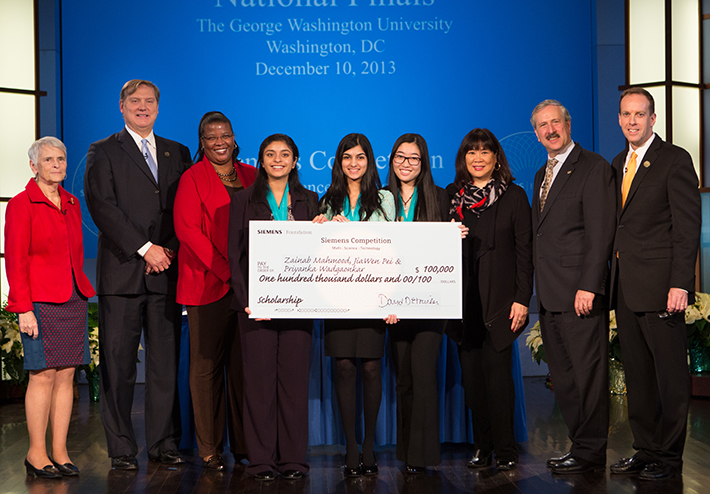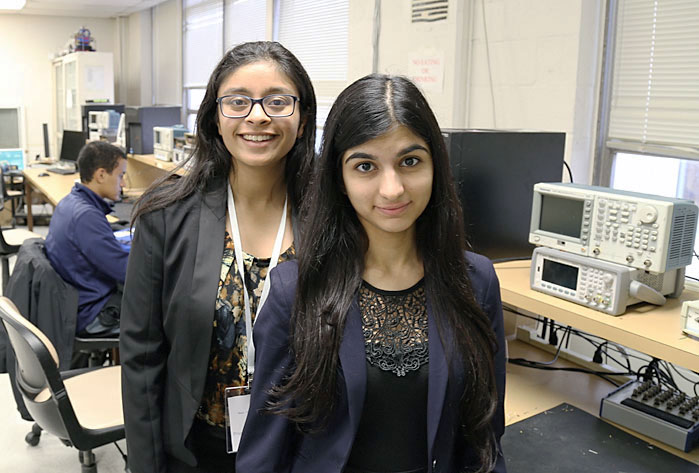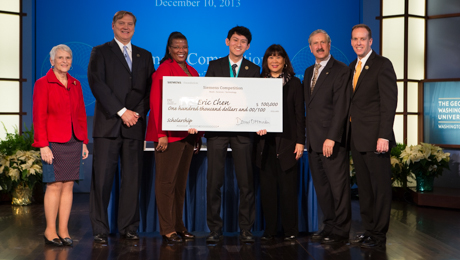Zainab Mahmood and Priyanka Wadgaonkar paced back and forth across their hotel room on the evening of Dec. 7, 2013 as they prepared for what the SiemensUSA president has called the “super bowl” of high school science competitions.
This week, Ms. Mahmood and Ms. Wadgaonkar are busy studying together in their Somers Hall room, as they gear up for a different kind of event: their first round of final exams at the George Washington University. But for these research partners turned college roommates, the pressure isn’t anything new.
Ms. Mahmood and Ms. Wadgaonkar won the $100,000 grand prize in the team category at last year’s Siemens Competition. The national contest invites high school students to present original research projects in the fields of science, technology, engineering and mathematics (STEM).
After spending five days last winter at GW, which has hosted the competition for the past five years, the two best friends decided to make the university their home for the next four years.
Ms. Mahmood is a freshman studying biomedical engineering in the School of Engineering and Applied Science (SEAS) and is a Clark Engineering Scholar. Ms. Wadgaonkar is a freshman studying biology in the Columbian College of Arts and Sciences and plans to become a physician. Both students are also members of the Elizabeth J. Somers Women's Leadership Program in the science, health and medicine cohort.
During last year’s event, the high school students met with SEAS Dean David Dolling as well as SEAS faculty and students. They also toured the Foggy Bottom Campus, learned about undergraduate research opportunities and met with SEASSPAN mentors, a group of SEAS students who help incoming freshmen transition to the university.
“We were looking at GW, but we weren’t so sure,” Ms. Mahmood said. “Getting to meet professors and students last year, and seeing student research during the poster presentations really helped us make our choice.”
In addition to GW’s close proximity to agencies like the National Institutes of Health, the promise of the Science and Engineering Hall, which opens to students and researchers in January, was a big draw for the young scientists.
“That’s something I really liked about GW—there is a lot of integration between the different sciences, and the new hall is a really good example of that,” Ms. Wadgaonkar said. “You could be doing biology next to a physics room, which is right next to an engineering lab. And that’s really what research is like. There is really no one area that you can stay in.”

(From left) Priyanka Wadgaonkar, Zainab Mahmood and team member Jiawen Pei receive their $100,000 grand prize in the team category at last year's Siemens Competition hosted at GW.
On Tuesday, Ms. Mahmood and Ms. Wadgaonkar returned to Jack Morton Auditorium to watch this year’s cohort of Siemens competitors receive their awards.
“It was nice to just sit back and watch someone else do all the work,” Ms. Wadgaonkar said with a laugh. “We know firsthand all the stress that comes along with this.”
Their journey to GW began when they were freshmen at Hewlett High School in Long Island, where their biology teacher, “Dr. B.,” encouraged his students to formulate a scientific question for the Siemens Competition. By junior year, the students secured an idea and started their experiment.
Ms. Mahmood, Ms. Wadgaonkar and their third team member chose to investigate whether there was a correlation between a particular plant gene and ozone resistance. Ground-level ozone, a toxic gas caused by a reaction between air pollution and sunlight, can be a major crop killer, especially in large cities, Ms. Wadgaonkar said.
“First we identified it, and then we tried to find out what its function was, because no one really knew what this gene did,” Ms. Mahmood said. “All we knew about it to begin with was that it was present in all these major crops and in ferns.”
The students used a technique known as “gene knockout” to discover the potential link between ozone resistance and the gene. They found that once they knocked out the gene—making it ineffective—and exposed their fern to ozone, the plant did not grow as well as their control plant. With this discovery, the gene could be over-expressed or inserted into other crops to protect against harmful air pollutants, as well as other stressors, like cold and salt, the students explained.
At GW, Shahrokh Ahmadi, the students’ professor for an introductory engineering course, suggested that they continue their research with Mathew Kay, an associate professor in the Department of Biomedical Engineering. Next semester, Ms. Mahmood and Ms. Wadgaonkar will work with Dr. Kay on a project to more quickly identify heart attacks using 3-D printers.
Dr. Ahmadi said the Siemens winners’ choice to come to GW speaks volumes about the caliber of the university and its growing reputation as a top research institution.
“These are very analytical students. They do a thorough comparison of all the universities,” he said. “And after all of those comparisons, they eventually chose GW.”
He added that the benefit of the Siemens Competition is twofold: Not only does it provide high school students with the research and presentation skills that they’ll eventually need as they continue their education, but it also helps to attract the “cream of the crop” to GW.
“When you bring good students to the university, then good things happen. Other students see their performance, and we can have even better students. It becomes an evolving cycle,” he said. “And that lets the school move up in every direction.”



